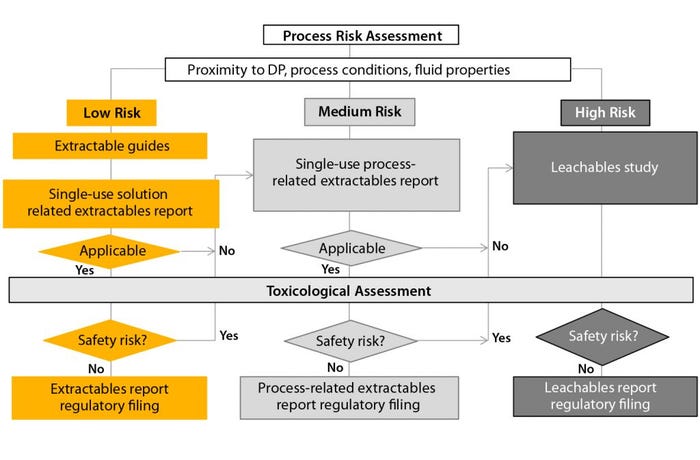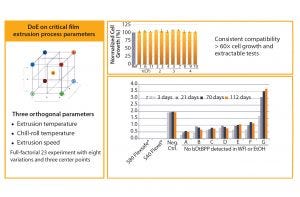- Sponsored Content
Control of Single-Use System Supply ChainsControl of Single-Use System Supply Chains
December 11, 2017
Sponsored Content
Single-use technologies are now dominant for the clinical production of biopharmaceuticals and are becoming more mainstream within commercial manufacturing facilities. They allow biologics manufacturers to decrease the footprint of their facilities by approximately 20% because of a reduced need for utilities that generate water, steam, and clean-in-place solutions. Engineers believe that the capital outlay for a single-use facility is 25–45% less than for a facility based on stainless steel equipment. Similarly, they estimate that such facilities need half the water and energy during operations and can be constructed in as little as 18 months. That is in contrast to the three years it can take to get a stainless steel facility up and running. Furthermore, the risk of product cross-contamination between batches is considerably reduced.
Biomanufacturers must be able to trust single-use technology as they implement it into increasingly critical bioprocessing process steps and applications. We have seen evidence that a single bag failure can cost manufacturers between US$100,000 and $1 million and that, each year, leaks in single-use systems have resulted in the loss of product valued at up to $20 million. Changes to the raw materials used in production of single-use systems must be analyzed by biopharmaceutical producers, a process that can cost €100,000 per change. What is worrying for process scientists is increasing evidence to show that some single-use materials are biologically active. A recent study by the DECHEMA society for chemical engineering and biotechnology showed that 7 out of 11 readily available bags on the market inhibited or interfered with cell growth.
The industry must address four key challenges that biomanufacturers face when developing a single-use system: It needs to ensure that the technology does not interact with living cells or biological products, that it is a closed and integral system, that it does not leak, and that its supply is ensured. Finally, such systems must reduce complexity, improve quality, and minimize the burden of change controls through standardization. The solutions to these challenges are interrelated, but they depend on improving control of raw materials, components, and processes within the supply chain.
How to Achieve Those Goals
How can suppliers support biomanufacturers and limit the impact of possible incompatibilities between production technologies and biological systems? First, we need to understand how plastics can interact with bioprocesses. Extractables are chemicals originating from single-use materials and manufacturing processes that can be extracted under worst-case conditions. Leachables are a subset of extractables that enter the manufacturing process under normal operating conditions. They can inhibit cell growth, alter protein expression, or change the structure of biological products through processes such as oxidation and unfolding. Particles also can find their way into bioprocesses from the external environment or from materials (such as plastics) that operators use during processing. Both leachables and particles can be immunogenic or thrombogenic, or they can lead to embolization in patients.
Extractables, Leachables: Biomanufacturers need to be certain that the exposure of cultures and products to extractable compounds will be consistent for every batch of biologic produced. Suppliers of single-use systems must characterize their materials and processes thoroughly, then ensure consistency through incoming material specifications, design spaces, process controls, and change control mechanisms. Sartorius Stedim Biotech has characterized the extractables present in all single-use system components according to the industry-accepted BioPhorum Operations Group (BPOG) methodology and the company’s own methods, which it believes to be more stringent. Sartorius Stedim Biotech has developed a simplified schematic to guide customers when developing their filing strategy and help them determine whether vendor data on extractables will suffice, whether a simulation study is required, or whether full leachables testing is needed (Figure 1).

Figure 1: Simplified schematic for development of a risk-assessment filing strategy — simple validation by connecting existing extractables with specific process conditions to simulate leachables
To achieve the necessary level of reproducibility, the company has thoroughly characterized its resins and established the design space of S80 film used in Flexsafe® bags by performing full-factorial 23 design of experiments (DoE) based on extrusion temperature, chill-roll temperature, and extrusion-speed process parameters. Films produced from across the design space gave consistent biocompatibility performance in over 60 tests. Furthermore, the studied films gave normalized cell-growth performance that was comparable to a reference and showed no cell-growth inhibition. The supplier’s knowledge of film manufacturing has allowed it to set resin specifications and design spaces that ensure Flexsafe® bags reproducibly will not release detectable amounts of the compound bDtBPP, which is a known cell-growth inhibitor, into solutions stored for up to 112 days at 40 °C (Figure 2).

Figure 2: Film extrusion design of experiments (DoE) guarantee consistent compatibility in the entire design space.
Control of particulates in bioprocesses can be just as important as controlling extractables and leachables. Our primary concern is the control and reduction of visible particles, greater than 100 microns, which could enter the product formulation. It is our belief that the industry can reduce problems caused by particles by understanding the main mechanisms by which they are generated and then taking steps to eliminate those components and operations shown to be significant contributors to the overall particle burden. We increase the cleanliness of our components by our partnerships with suppliers that guide major improvements. Südpack, for example, extrudes our film under conditions that meet the particulate specifications of an ISO Class 7 environment under activity. We have also implemented incoming component inspections against specifications, perform regular supplier audits and we continuously improve our own cleanroom operations to reduce sources of contamination. All of our 2D and 3D bags and mixing containers undergo visual inspection during production while our finished product assemblies destined for drug substance and drug product processing applications receive an extended visible particle inspection before release.
Leaks: Suppliers of single-use systems have a vital role to play in minimizing the risks that biomanufacturers face from leaking single-use assemblies. In addition to applying quality by design (QbD) principles and improving the robustness of films, welds, and connections, the company has implemented integrity tests throughout the entire life cycle of an assembly. When making bag chambers, Sartorius Stedim Biotech performs an in-process pressure-decay test to the ASTM F2095 standard with a detection limit of 40–100 μm. In addition, the company can perform a helium-based supplier integrity test on entire, finished single-use assemblies for critical applications — a sensitive test can detect defects as small as 2 μm in size. For an extra level of integrity assurance, customers can benefit from a point-of-use leak test technology that allows the detection of defects in the range 10–100 μm before using a bag in their applications. Find more details of those tests elsewhere in this report.
Standardization: The biopharmaceutical industry often has highlighted problems with large numbers of nonstandard consumables within its supply chain. That leads to additional complexity and cost but also can have a real impact on quality, change control, and assurance of supply. The company has developed a large number of predesigned solutions using off-the-shelf standard components for a broad range of process steps and applications. By taking advantage of those predefined solutions, biomanufacturers can ensure that they receive notice of changes 24 months before they occur. We believe that standardization allows the highest levels of delivery performance, the greatest assurance of supply, and the most optimized inventory of parts.
Ensured Supply: Receiving an assurance of supply of single-use systems is critical to manufacturers of biopharmaceuticals for commercial supply. In addition to the two years guaranteed supply of unchanged components within its predesigned solutions, Sartorius Stedim Biotech has signed long-term supply and quality contracts with its own suppliers and implemented stocking policies that allow it to provide customers with four-year guarantees of unchanged films used in bag chambers. The company operates multiple manufacturing sites with >7,000 m2 of cleanroom capacity located around the globe for full business continuity planning.
A Science-Led Approach
Biotechnology companies increasingly are implementing single-use technologies for the commercial production of biopharmaceuticals to improve speed, efficiency, flexibility, and costs. Biomanufacturers and their suppliers are combining expertise and using a science-led approach to gain end-to-end control of these technologies. Control of materials, production processes, and quality can reduce variability, ensure consistent compatibility with biological systems, and increase process integrity.
The following articles address the range of technological developments in single-use bioprocessing that will allow bioprocess engineers to develop more efficient and flexible processes without compromising on the robustness of single-use systems or associated supply chains. •
Jean-Marc Cappia is group VP of marketing and product management in fluid management technologies at Sartorius Stedim Biotech FMT.
You May Also Like






